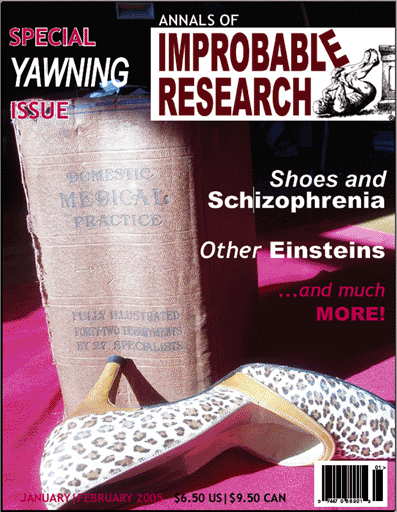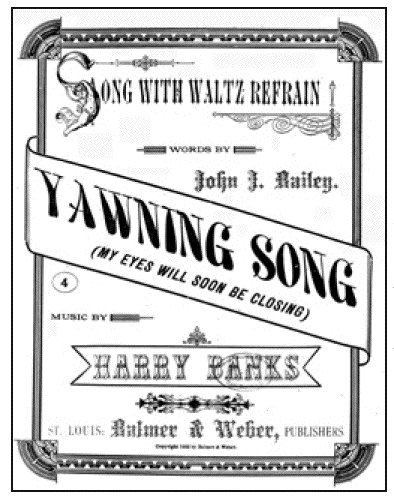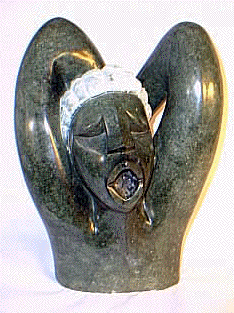- Improbable
research pdf
-
- In science, the yawn has not received its
due attention. In this investigation I provide
(1) a systematic-encyclopedic overview of all
available knowledge about yawning. The fields
from which I derive my data are linguistics
(semantics, etymology), sociology, psychology,
the medical sciences (anatomy, physiology,
pathology, and pharmacology), and the arts
(literature, film, visual arts). Then, I (2)
associate a number of these data in order to (3)
test the hypothesis that yawning has an erotic
side, a sexual aspect.
-
- A Taboo, an Unsolved Riddle
- The mass of data that I present in the
encyclopedic overview makes one thing clear:
there is no good explanation for yawning.
-
- As regards physiology: the hypoxia and
hypercapnia theories -- these long-untested
theories that also figure prominently in
common-sense notions -- were conclusively
refuted by Robert Provine and his collaborators
(Provine, Tate, and Geldmacher 1987). The now
popular theory that yawning leads to wakefulness
('arousal defense reflex,' Askenasy 1989) is not
without its problems (Regehr, Ogilvie, and
Simons 1992).
-
- In the paragraphs on pathology and
pharmacology I enumerate so many different
illnesses and disorders that are associated with
increased yawning that for the moment it is
impossible to extract a common factor. The same
goes for the very many chemical substances that
induce yawning (Crenshaw and Goldberg 1996: 415;
Argiolas and Melis 1998: 12). What this common
pharmacological factor, if there is one,
constitutes, remains unclear.
-
 -
- In the chapter on the psychology of yawning
I discuss various subthemes of which the most
concrete are: contagiousness, non-verbal
behavior, and conditionability. Neither of these
subthemes has been completely clarified.
Psychologically, too, the yawn is still very
much an unsolved riddle.
-
- In the chapter on the sociology of the yawn
I note that the yawn is (quasi-)universally
taboo. The reason why this is so remains
shrouded in mystery: the various rationales
given -- superstitious, hygienic, aesthetic,
psychological -- are all implausible. The
ethological rationale (bared teeth) may turn out
to provide the best explanation for the taboo of
yawning.
-
- As a preliminary conclusion we may therefore
state that Reber's Law applies perfectly to the
hitherto considered trivial behavior of yawning:
the closer the yawn is examined, the more
complex it is seen to be (Reber 1985: 618). In
fact, we have really no idea what causes yawning
and what purpose yawning serves or what
mechanisms are responsible for yawning and even
what the essential anatomical constituents of
yawning are. In the age in which the human
genome has been deciphered and space travel has
become almost trite this verdict may sound like
an affront.
-
- Eroticism-Sexuality
- Yet, in the light of the hypothesis that
yawning has an erotic side, it becomes clear
that in the data that I gathered there is at
least one recurrent theme: eroticism-sexuality.
I found that both the 'yawn' and the 'stretch'
of the stretch-yawn syndrome (SYS) are
semantically and etymologically associated with
'desire' and 'longing for' (de Vries 1991:
142).
-
- In several proverbs and sayings yawning --
and especially contagious yawning -- is
interpreted as a clue of something more than
just sympathy, that is, as a sign of being in
love (Schlossar 1891: 402; Hand 1981, no. 12964;
Beyer 1985: 187). Yawning was both linked with
acedia-boredom and with luxuria (lechery) and
passion. As a non-verbal behavior the yawn was
found to figure -- be it consciously or
unconsciously -- in the courtship process
(Howell 1659: 14; Mantegazza 1890: 126;
Féré 1905; Givens 1978). That this
is not a purely recent or western phenomenon was
illustrated by passages from ancient Indian
literature (Vatsyayana 1965; Biharilal 1990;
Kesavadasa 1993).
-
- Not surprisingly perhaps, the few
psychoanalysts and depth-psychologists who did
mention the yawn interpreted it as a latent
sexual signal (Meerloo 1955: 65; Marcus 1973;
Felstein 1976).
-
- Ethological studies in primates found a
clear relationship between yawn-frequency and
hierarchical status (Bielert 1978; Hadidian
1980; Deputte 1994) and between yawn-frequency
and the serum level of testosterone (Chambers
and Phoenix 1981).
-
- In discussing anatomy and physiology I
recounted that Chouard and Bigot-Massoni (1990:
146, 152) described the feeling that accompanies
the acme of yawning as a 'mini orgasm'.
Moreover, the same authors concluded: "Let us
remember in conclusion its intimate and
unconscious relation with sexual life,
[…]." (ibidem).
-
- In discussing pathology I discovered that
yawning and spontaneous ejaculation were
mentioned concomitantly in terminal rabies (Beek
1969: 127).
-
- In discussing pharmacology I found a link
between yawning and spontaneous orgasm in
withdrawal from heroin addiction (Parr 1976).
Likewise, yawning and sexual response (SR) were
associated as clinical side effects of several
antidepressant drugs. In one publication an
undeniable causal relation was reported: both
spontaneous and intentional yawning provoked
instantaneous ejaculation-orgasm (McLean,
Forsythe, and Kapkin 1983). In experiments with
animals many more substances were seen to
induce, sometimes simultaneously, both SYS and
SR. Moreover, in humans apomorphine induces both
SYS and SR (Lal et al. 1989).
-
- In the chapter on yawning and the arts, I
discussed, in a somewhat more conjectural
manner, the conspicuously erotic sigh and the
equally erotic posture X. I argued for the
interpretation of the sigh and posture X as the
auditory and visual proxies for the SYS.
-
- My Conclusions About Yawning
- It is because of the critical mass of
circumstantial evidence that was accumulated
that all these data, passages, and quotations
take on an ambivalent or double meaning. Nowhere
is that clearer than in the use of the words
'yawning' and 'stretching' in the poetry of W.
B. Yeats (1989 [1929]: 379), as for
instance in:
-
- O cruel Death give three things back,
- Three dear things that women know,
- [...]
- The third thing that I think of yet,
- [...]
- Is that morning when I met
- Face to face my rightful man
- And did after stretch and yawn.
- And what to think of the following passage
taken from The Prime of Miss
- Jean Brodie by Muriel Spark (1967
[1961]): 59) in which the pupils
Jenny
- and Sandy discuss their teacher's love
life?
- For this reason she was more reticent than
Jenny about the details of the
- imagined love affair. Jenny whispered, 'They
go to bed. Then he puts out
- the light. Then their toes touch. And then
Miss Brodie… Miss Brodie…'
- She broke into giggles.
- 'Miss Brodie yawns,' said Sandy in order to
restore decency, now that she
- suspected it was all true.
- This, of course, does not mean that every
yawn can be interpreted as erotic
- or even sexual: "There are times when a yawn
is simply a yawn." (Even if a
- 'simple' yawn is not simple at all.)
-
- In 'The Thinking of Thoughts: What is Le
Penseur Doing?' Gilbert Ryle
- (1971: 480) presented the example of the
blink of an eye to illustrate the necessity to
interpret individual behavioral acts.
- Equally, we cannot but interpret every
individual yawn as the occasion arises. In
everyday life each and every individual
- yawn must be interpreted, as it cannot be
ascribed to one specific cause, or be explained
with total certainty. Likewise, we
- face a 'prediction barrier' in experiment
and observation when predicting individual
yawns.
-
- In summary, the two foremost
conclusions of my investigation are (1) the yawn
is -- contrary to common-sense ideas -- far from
trivial; yawning is an extremely complex
behavior. (2) The yawn -- and this clashes even
more with common-sense
- notions -- appears to have an erotic side, a
sexual aspect.
 - Bibliography
- "The Neuropharmacology of Yawning," Antonio
Argiolas and Maria R. Melis, European Journal of
Pharmacology, vol.
- 343, no. 1, 1998, pp. 1-16.
-
- "Is Yawning an Arousal Defense Reflex?"
J.J.M. Askenasy, Journal of Psychology, vol.
123, no. 6, 1989, pp. 609-21.
-
- Waanzin in de Middeleeuwen, Henri H. Beek,
Nijkerk (Netherlands): Callenbach, 1969.
-
- "Androgen Treatments in Young Male Rhesus
Monkeys," F. Bielert, in Recent Advances in
Primatology, ed. D. Chivers and J. Herbert, vol.
1, pp. 485-88, London: Academic Press,
1978.
-
- Sprichwörterlexikon, Helmut Beyer,
Munich: Beck, 1985.
-
- The Satsai, Biharilal, trans. K. P. Bahadur,
New Delhi: Penguin India, 1991 [originally
c. 1647].
-
- "Diurnal Patterns of Testosterone,
Dihydrotestosterone, Estradiol, and Cortisol in
Serum of Rhesus Males: Relationship to
- Sexual Behavior in Aging Males," Kathleen C.
Chambers and Charles H. Phoenix, Hormones and
Behavior, vol. 15, no. 4,
- 1981, pp. 416-26.
-
- "Mécanismes et Rôles
Physiologiques du Bâillement," C. H.
Chouard and D. Bigot-Massoni, Annales
d'oto-laryngologie
- et de chirurgie cervico-faciale (Paris),
vol. 107, no. 3, 1990, pp. 145-53.
-
- Sexual Pharmacology: Drugs That Affect
Sexual Functioning, Theresa L. Crenshaw and
James P. Goldberg, New York:
- Norton, 1996.
-
- "Ethological Study of Yawning in Primates.
I. Quantitative Analysis and Study of Causation
in Two Species of Old World
- Monkeys (Cercocebus albigena and Macaca
fascicularis)," Bertrand L. Deputte, Ethology,
vol. 98, 1994, pp. 221-45.
-
- "Oh! What a Big Yawn," Ivor Felstein, Pulse
(London), March 6, 1976, p. 7.
-
- "Note sur le Bâillement," Charles
Féré, Comptes Rendus des
Séances de la Société de
Biologie (Paris), vol. 59, no. 1, 1905,
- pp. 11-12.
-
- "The
Non-Verbal Basis of Attraction: Flirtation,
Courtship and Seduction," David B. Givens,
Psychiatry, vol. 41, no. 4,
- 1978, pp. 346-51.
-
- "Yawning in an Old World Monkey, Macaca
nigra (Primates: Cercopithecidae)," John
Hadidian, Behaviour, vol. 75, no. 3-4,1980, pp.
133-47.
-
- Popular Beliefs and Superstitions: A
Compendium of American Folklore. W. D. Hand,
Boston: G. K. Hal, 1981.
-
- Lexicon Tetraglotton: Proverbs Old
Sayed-Sawes and Adages in the English Toung;
etc. James Howell, London: Thomas
- Leach, 1659.
-
- Rasikapriya, Kesavadasa, unpublished
translation by G. H. Schokker, Leiden /
Wassenaar, 1993 [originally c.
1600].
-
- "Apomorphine: Clinical Studies on Erectile
Impotence and Yawning," Samarthji Lal, Y.
Tesfaye, Joseph X. Thavundayil, T.
- R. Thompson, M. E. Kiely, N. P. Nair,
Alejandro Grassino, Bernardo Dubrovsky, Progress
in Neuro-Psychopharmacology
- & Biological Psychiatry, vol. 13, no.
3-4, 1989, pp. 329-39.
-
- "Unusual Side Effects of Clomipramine
Associated with Yawning," D. McLean, R. G.
Forsythe, I. A. Kapkin, Canadian
- Journal of Psychiatry, vol. 28, no. 7, 1983,
pp. 569-70.
-
- Physiognomy and Expression, Paolo
Mantegazza, London: Scott, 1890.
-
- "Yawning: Analytic and Therapeutic
Considerations," Ned Marcus, International
Journal of Child Psychotherapy, vol. 2,
- no. 4, 1973, pp. 406-18.
-
- "Archaic Behavior and the Communicative Act:
The Meaning of Stretching, Yawning, Rocking and
Other Fetal Behavior
- in Therapy," Joost A. M. Meerloo,
Psychiatric Quarterly, vol. 29, no. 1, 1955, pp.
60-73.
-
- "Sexual Aspects of Drug Abuse in Narcotic
Addicts," Denis Parr, British Journal of
Addiction, vol. 71, no. 3, 1976, pp.
- 261-68.
-
- "Yawning: No Effect of 3-5% CO2, 100% O2,
and Exercise," Robert R. Provine, Bentley C.
Tate, Lisa L. Geldmacher,
- Behavioral and Neural Biology, vol. 48, no.
3, 1987, pp. 382-93.
-
- The Penguin Dictionary of Psychology, Arthur
S. Reber, Harmondsworth: Penguin, 1985.
-
- "Electrophysiological Correlates of
Yawning," Kimberly L. Regehr, Robert D. Ogilvie,
and Iain A Simons, Sleep Research,
- vol. 21, 1992, p. 14
-
- "The Thinking of Thoughts: What is 'Le
Penseur' Doing?" Gilbert Ryle, in Collected
Papers, 2 vols., vol. 2, pp. 480-96,
- London: Hutchinson, 1971.
-
- "Volksmeinung und Volksaberglaube aus der
deutschen Steiermark," Anton Schlossar, Germania
(Vienna), vol. 36, 1891,
- pp. 380-406.
-
- The Prime of Miss Jean Brodie, Muriel Spark,
Harmondsworth: Penguin 1967 [originally
1961].
-
- Kama-Sutra of Vatsyayana, Mallanaga
Vatsyayana, trans. and ed. S. C. Upadhyaya,
Bombay: Taraporevala, 1965 [originallyc.
350].
-
- Etymologisch Woordenboek, Jan de Vries,
Utrecht: Spectrum, 1991.
-
- Yeats's Poems, William ButlerYeats, ed. A.
Norman Jeffares, London: Macmillan, 1989.
-
- Le
réflexe sexuel de
l'élévation des bras chez la femme
Muhlrad S
|




